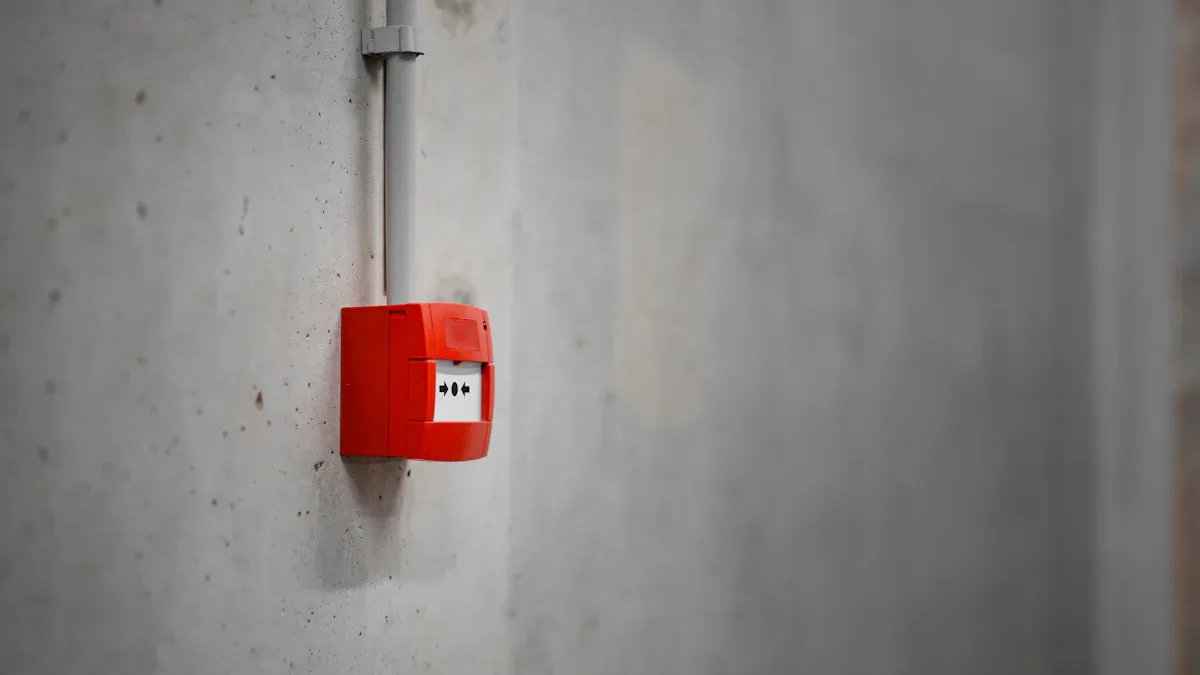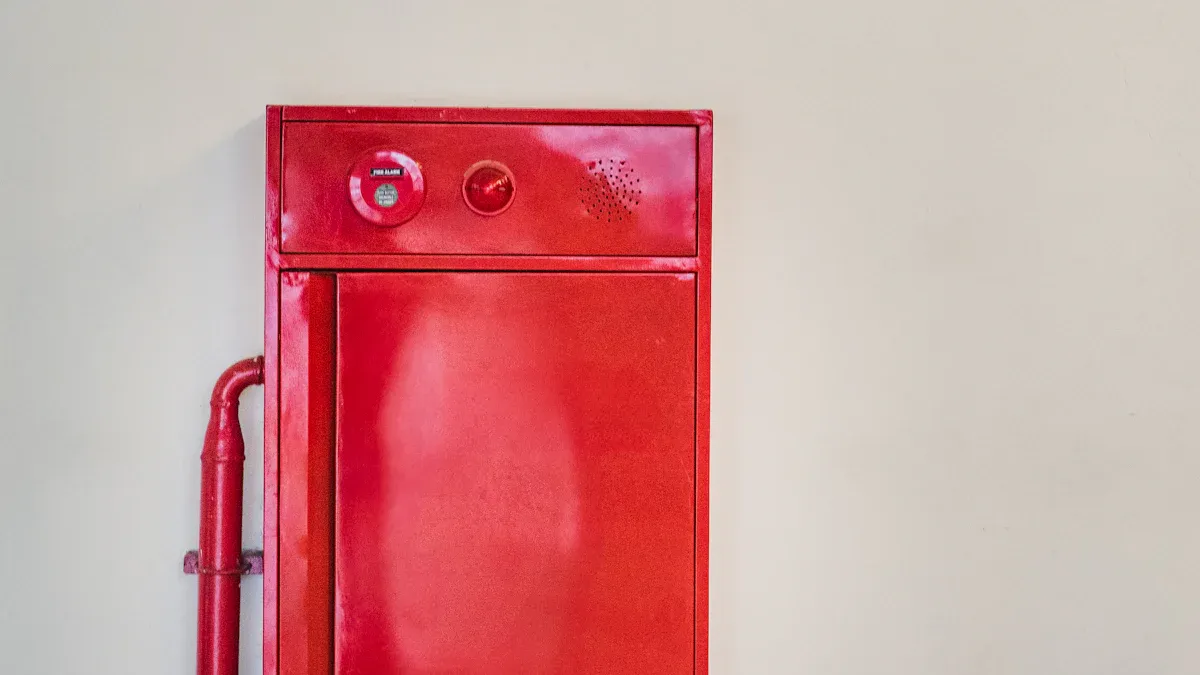
Fire alarm systems depend on reliable protection for critical communication devices. A telephone metal enclosure shields these components from fire, tampering, and environmental hazards. Manufacturers select materials and designs that pass rigorous tests, ensuring equipment stays safe and operational during emergencies.
Key Takeaways
- Telephone metal enclosures protect fire alarm communication equipment from fire, tampering, and harsh environments by meeting strict safety standards set by UL, NFPA, and NEMA.
- These enclosures use fire-resistant materials like aluminum, stainless steel, and galvanized steel, combined with smart designs to ensure durability, heat resistance, and secure cable management.
- Certified and tested enclosures with proper labeling guarantee reliable performance and easier approval by authorities, helping keep fire alarm systems safe and operational during emergencies.
Safety Standards for Telephone Metal Enclosure

UL, NFPA, and NEMA Requirements
Industry standards play a critical role in the design and performance of a telephone metal enclosure for fire alarm systems. Organizations such as Underwriters Laboratories (UL), the National Fire Protection Association (NFPA), and the National Electrical Manufacturers Association (NEMA) set benchmarks for safety, reliability, and durability.
- UL Standards: UL tests and certifies enclosures to ensure they resist fire, impact, and environmental hazards. UL 50 and UL 50E focus on construction and performance, while UL 864 addresses control units and accessories for fire alarm systems. A telephone metal enclosure with a UL listing demonstrates that it meets rigorous fire resistance and safety criteria.
- NFPA Codes: The NFPA 72 National Fire Alarm and Signaling Code outlines requirements for fire alarm system components, including enclosures. It mandates that enclosures protect wiring and equipment from fire, tampering, and environmental threats. NFPA 70, also known as the National Electrical Code (NEC), further specifies installation practices to reduce fire risks.
- NEMA Ratings: NEMA assigns ratings to enclosures based on their ability to withstand dust, water, and corrosion. For example, a NEMA 4 or 4X telephone metal enclosure offers protection against rain, hose-directed water, and corrosion, making it suitable for harsh environments.
Note: Metal enclosures outperform non-metal alternatives in fire resistance and mechanical strength. While non-metallic options may offer lighter weight and corrosion resistance, they often lack the fire safety compliance required for critical applications.
Building and Electrical Code Compliance
Building and electrical codes directly influence the design and installation of telephone metal enclosures. The National Electrical Code (NEC) provides detailed requirements to ensure safety and reliability in fire alarm system installations.
| NEC Code Section | Requirement Summary | Impact on Telephone Metal Enclosure Design and Installation |
|---|---|---|
| Sec. 110.3(B), Sec. 300.15 | Cable splices and terminations must be made in listed fittings, boxes, or enclosures | Enclosures must be code-listed and durable to protect splices and terminations |
| Sec. 760.130(B)(1-2) | Cables must be installed in metal raceways or rigid conduit where passing through floors or walls up to 7 ft height | Enclosures and raceways must be metal and provide physical protection in critical areas |
| Sec. 760.136(A-B) | PLFA cables must be separated from power conductors by barriers to prevent hazards | Enclosure design must include physical separation or barriers inside to segregate circuits |
| Sec. 760.143 | PLFA cables cannot be strapped or taped to the exterior of raceways for support | Enclosures must provide internal support and secure cable management, not external attachment |
| Sec. 300.4(A-D) | Cables must be protected from penetration by nails or screws, using steel plates or equivalent | Enclosures must be robust enough to prevent physical damage from building activities |
| Sec. 760.24(A) | Installation must be neat and workmanlike | Enclosure design and installation must facilitate organized cable routing and secure fastening |
| Sec. 110.11, Sec. 300.5(B), Sec. 300.6 | Materials must be suitable for corrosive, damp, or wet locations and identified for use | Enclosure materials must be selected for environmental suitability and durability |
| Sec. 300.15(C) | Bushings required where cables exit raceways to prevent abrasion | Enclosures must incorporate appropriate fittings to protect cable insulation |
| Sec. 760.124 | Fire alarm equipment and circuits must be durably marked and identified | Enclosures must allow clear labeling and identification for safety and maintenance |
Installers follow best practices to meet these code requirements:
- Use rigid metal conduit or intermediate metal conduit for cable protection.
- Maintain spacing from combustible materials to limit fire spread.
- Secure conduits with supports at regular intervals.
- Seal entry points to block unauthorized access and moisture.
- Choose non-combustible enclosures with ventilation for fire alarm equipment.
- Label cables clearly for easy maintenance.
- Organize cables inside the enclosure to prevent overcrowding.
A telephone metal enclosure designed and installed according to these codes ensures that fire alarm system wiring remains protected, organized, and accessible. This approach reduces the risk of fire, electrical hazards, and equipment failure during emergencies.
Compliance Features of Telephone Metal Enclosure

Fire-Resistant Materials and Construction
Manufacturers select materials for telephone metal enclosures that provide robust fire resistance and structural integrity. Aluminum offers lightweight strength and effective heat dissipation, while stainless steel delivers superior corrosion resistance and security. Powder-coated galvanized steel resists both fire and environmental hazards. These materials help enclosures withstand high temperatures and prevent the spread of flames, which is essential for protecting critical communication equipment during emergencies.
Design improvements focus on thermal management and explosion-proof features. Many enclosures now include modular structures and advanced surface treatments that enhance durability and simplify maintenance. Engineers use finite element analysis to optimize impact resistance and structural stability. These construction strategies ensure that the enclosure maintains its protective function even under extreme conditions.
| Material | Key Benefit | Application Example |
|---|---|---|
| Aluminum | Lightweight, heat dissipation | Outdoor telecom cabinets |
| Stainless Steel | Corrosion resistance, security | High-risk or coastal areas |
| Galvanized Steel | Fire resistance, durability | General building installations |
Manufacturers face challenges in selecting materials that balance fire resistance, durability, and cost. They must also ensure proper ventilation and grounding to prevent overheating and electrical faults.
Environmental and Tamper Protection
A telephone metal enclosure must protect sensitive equipment from both environmental hazards and unauthorized access. IP and NEMA ratings provide standardized measures of protection against dust, water, and temperature extremes. For example, an IP67-rated enclosure is dust-tight and can withstand temporary immersion in water. Achieving these ratings requires features such as silicone rubber gaskets, tightly mated parts, and waterproof adhesives. These design elements prevent moisture and dust from entering the enclosure, which helps maintain operational safety and extends equipment lifespan.
Robust construction using materials like stainless steel and aluminum resists corrosion and harsh weather. Weatherproof seals and UV-resistant coatings further enhance durability. Many enclosures incorporate passive and active cooling systems, such as ventilation fans and heat exchangers, to manage internal temperatures and prevent condensation. Surge protection modules and grounding systems shield equipment from voltage spikes caused by lightning or grid faults.
Tamper protection features include reinforced doors, tamper-proof locking mechanisms, and hidden cable entries. Some designs integrate electronic security systems and alarm triggers to deter theft and vandalism. These combined features ensure that the telephone metal enclosure maintains equipment integrity and continuous operation, even during emergencies.
- Ruggedized construction resists wind, rain, snow, and solar radiation.
- Sealed gaskets and anti-condensation vents block dust and moisture.
- Secure locking systems and surveillance integration deter unauthorized access.
Certification, Testing, and Labeling
Certification and labeling processes play a vital role in ensuring that telephone metal enclosures meet and maintain safety standards. Third-party certification bodies, such as UL and FM, conduct rigorous initial testing and ongoing inspections. These organizations evaluate enclosures for compliance with electrical, fire, structural, and environmental standards. Regulatory authorities, including OSHA and local inspectors, require certification labels from recognized laboratories before approving installations.
- Certification confirms that the enclosure has passed standardized safety tests.
- Labels produced under strict standards, such as UL 969, guarantee durability and accuracy.
- Regular audits and follow-up inspections ensure manufacturers maintain consistent production quality.
- Certification labels simplify inspection and approval, reducing liability and building trust with customers and authorities.
- Modifications to certified enclosures may require re-certification to maintain compliance.
Manufacturers must use authorized label suppliers and follow specific labeling standards to avoid legal issues or recalls. Labels are designed to withstand harsh conditions, ensuring readability and compliance throughout the product lifecycle. The certification process adapts to evolving safety requirements, with UL and other bodies aligning their standards with local regulations.
Certification and labeling provide clear evidence of compliance, making it easier for regulatory authorities to approve telephone metal enclosures for use in fire alarm systems.
A telephone metal enclosure built to NEMA 4 standards shields emergency communication equipment from dust, weather, and other hazards. This protection ensures reliable operation during critical events. By meeting strict certification requirements and using durable materials, these enclosures support dependable fire alarm system performance in emergencies.
FAQ
What is the main purpose of a telephone metal enclosure in fire alarm systems?
A telephone metal enclosure protects communication equipment from fire, tampering, and environmental hazards. It ensures reliable operation during emergencies.
How do manufacturers prove compliance with safety standards?
Manufacturers obtain certifications from organizations like UL or NEMA. They display labels on enclosures to show compliance with fire, electrical, and environmental safety standards.
Can a non-metal enclosure meet fire alarm system requirements?
Most non-metal enclosures do not meet strict fire resistance standards. Metal enclosures provide better protection for critical communication equipment in fire alarm systems.

